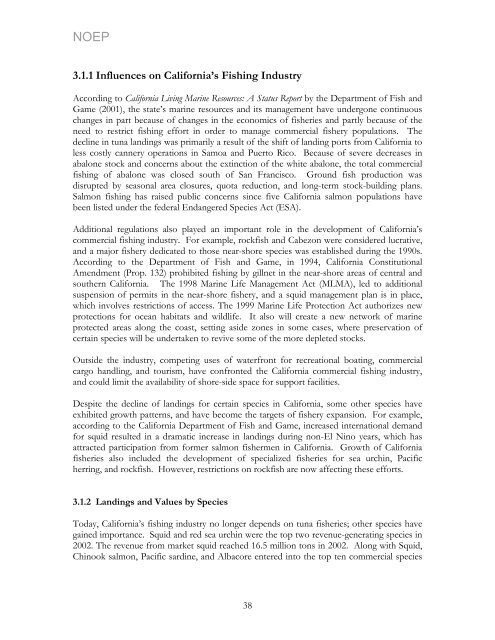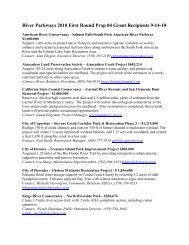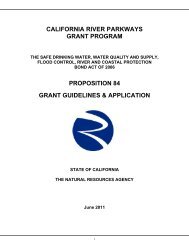California's Ocean Economy - California Resources Agency - State ...
California's Ocean Economy - California Resources Agency - State ...
California's Ocean Economy - California Resources Agency - State ...
Create successful ePaper yourself
Turn your PDF publications into a flip-book with our unique Google optimized e-Paper software.
NOEP<br />
3.1.1 Influences on <strong>California</strong>’s Fishing Industry<br />
According to <strong>California</strong> Living Marine <strong>Resources</strong>: A Status Report by the Department of Fish and<br />
Game (2001), the state’s marine resources and its management have undergone continuous<br />
changes in part because of changes in the economics of fisheries and partly because of the<br />
need to restrict fishing effort in order to manage commercial fishery populations. The<br />
decline in tuna landings was primarily a result of the shift of landing ports from <strong>California</strong> to<br />
less costly cannery operations in Samoa and Puerto Rico. Because of severe decreases in<br />
abalone stock and concerns about the extinction of the white abalone, the total commercial<br />
fishing of abalone was closed south of San Francisco. Ground fish production was<br />
disrupted by seasonal area closures, quota reduction, and long-term stock-building plans.<br />
Salmon fishing has raised public concerns since five <strong>California</strong> salmon populations have<br />
been listed under the federal Endangered Species Act (ESA).<br />
Additional regulations also played an important role in the development of <strong>California</strong>’s<br />
commercial fishing industry. For example, rockfish and Cabezon were considered lucrative,<br />
and a major fishery dedicated to those near-shore species was established during the 1990s.<br />
According to the Department of Fish and Game, in 1994, <strong>California</strong> Constitutional<br />
Amendment (Prop. 132) prohibited fishing by gillnet in the near-shore areas of central and<br />
southern <strong>California</strong>. The 1998 Marine Life Management Act (MLMA), led to additional<br />
suspension of permits in the near-shore fishery, and a squid management plan is in place,<br />
which involves restrictions of access. The 1999 Marine Life Protection Act authorizes new<br />
protections for ocean habitats and wildlife. It also will create a new network of marine<br />
protected areas along the coast, setting aside zones in some cases, where preservation of<br />
certain species will be undertaken to revive some of the more depleted stocks.<br />
Outside the industry, competing uses of waterfront for recreational boating, commercial<br />
cargo handling, and tourism, have confronted the <strong>California</strong> commercial fishing industry,<br />
and could limit the availability of shore-side space for support facilities.<br />
Despite the decline of landings for certain species in <strong>California</strong>, some other species have<br />
exhibited growth patterns, and have become the targets of fishery expansion. For example,<br />
according to the <strong>California</strong> Department of Fish and Game, increased international demand<br />
for squid resulted in a dramatic increase in landings during non-El Nino years, which has<br />
attracted participation from former salmon fishermen in <strong>California</strong>. Growth of <strong>California</strong><br />
fisheries also included the development of specialized fisheries for sea urchin, Pacific<br />
herring, and rockfish. However, restrictions on rockfish are now affecting these efforts.<br />
3.1.2 Landings and Values by Species<br />
Today, <strong>California</strong>’s fishing industry no longer depends on tuna fisheries; other species have<br />
gained importance. Squid and red sea urchin were the top two revenue-generating species in<br />
2002. The revenue from market squid reached 16.5 million tons in 2002. Along with Squid,<br />
Chinook salmon, Pacific sardine, and Albacore entered into the top ten commercial species<br />
38







